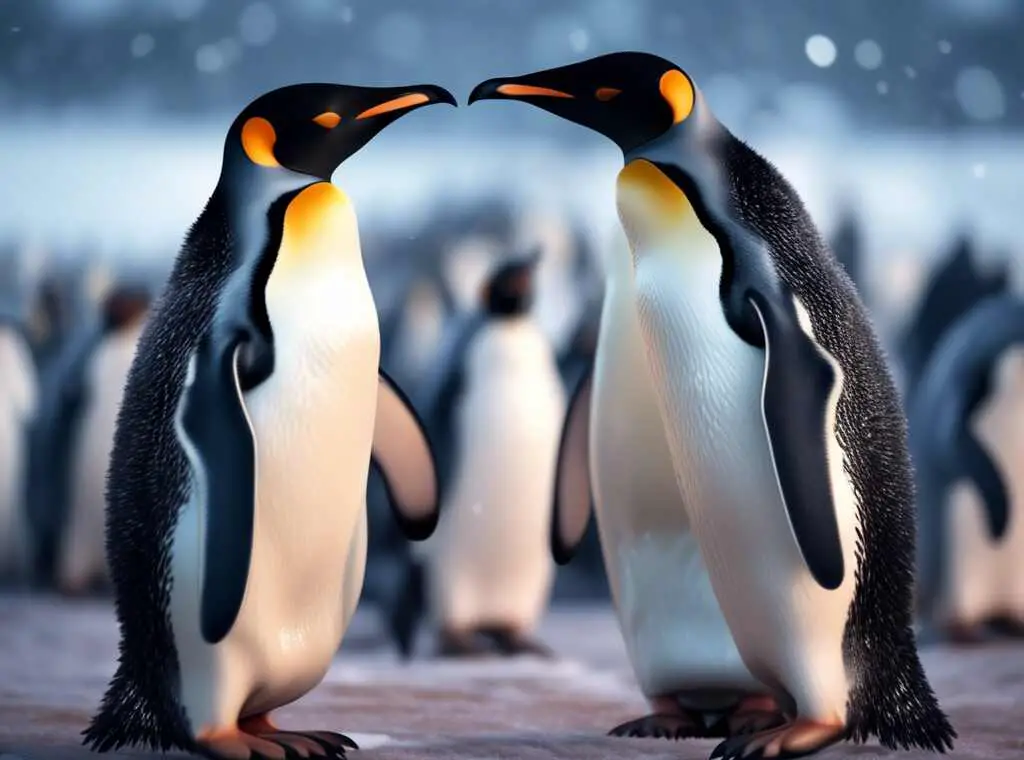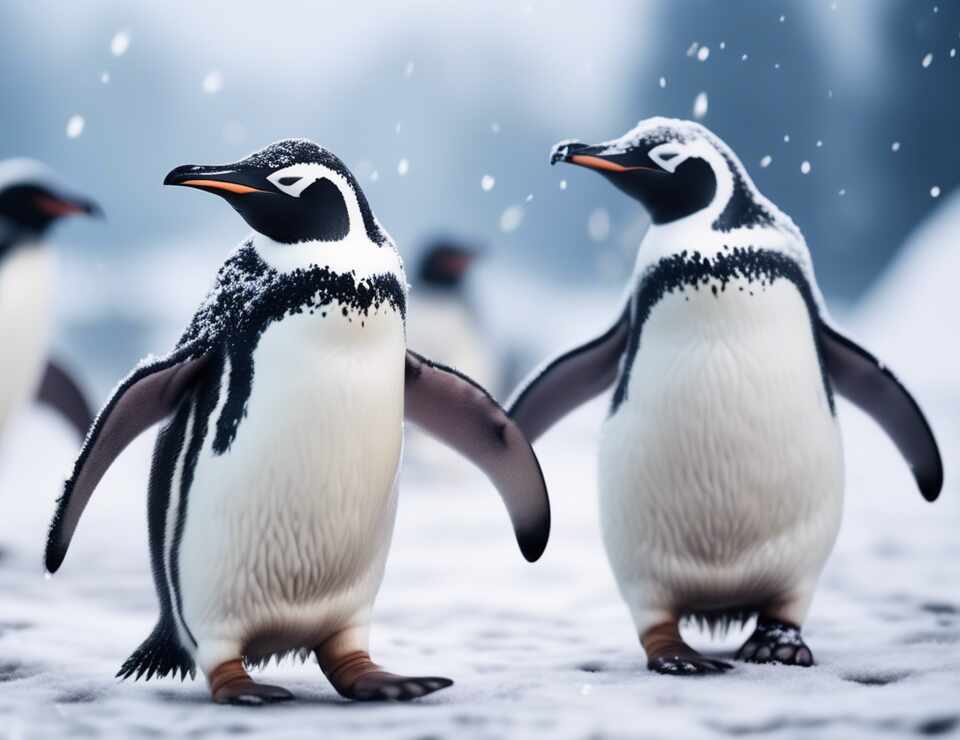Penguins are fascinating creatures that have evolved unique ways to survive in the extreme cold of their icy habitats. Their ability to stay warm in sub-zero temperatures is a result of several remarkable adaptations that enable them to thrive in some of the harshest environments on Earth.
Table of Contents
How Do Penguins Stay Warm in the Cold?
Fluffy Layers of Feathers Provide Insulation
One of the key ways penguins stay warm in the cold is through their remarkable layer of feathers. Penguins have a dense layer of small, fluffy feathers that effectively trap air close to their bodies, providing insulation against the frigid temperatures that they encounter in their polar habitats. This layer of feathers traps a layer of warm air next to the penguin’s body, preventing heat loss to the surrounding icy waters.
Huddling Together for Warmth
In cold weather, penguins often gather together in large groups, a behavior known as huddling, to conserve body heat. By huddling together, penguins can share body heat and collectively stay warmer than they would be individually. The penguins on the outer edge of the huddle rotate to the center periodically, allowing each penguin to benefit from the warmth of the group.
Thick Layer of Blubber
Underneath their outer layer of feathers, penguins have a thick layer of blubber, which serves as an additional layer of insulation to help them stay warm in icy waters. This layer of blubber acts as a valuable energy reserve and provides essential warmth, especially during long periods spent swimming in cold ocean waters.
Countercurrent Heat Exchange System
Penguins have a unique physiological adaptation known as a countercurrent heat exchange system, which helps them retain body heat. In this system, arterial blood carrying warm oxygenated blood to the penguin’s extremities is cooled by venous blood returning from the flippers and feet. This heat exchange mechanism helps prevent heat loss through the extremities, ensuring that vital organs receive a constant blood supply and remain warm.
Heat-Retaining Black Plumage
The black and white coloration of penguin plumage serves a critical role in helping them stay warm. The black feathers on their backs absorb heat from the sun, allowing penguins to warm up quickly after returning from cold swims in the ocean. In contrast, the white feathers on their bellies help them blend in with the bright surface of the ice above and the dark depths of the ocean below, providing camouflage from predators.
Tucking Flippers Close to the Body
When temperatures drop even further, penguins can conserve heat by tucking their flippers close to their bodies. By minimizing the exposure of their extremities to the cold air, penguins can reduce heat loss and maintain their body temperature even in freezing conditions.
The remarkable adaptations of penguins, including their fluffy layers of feathers, huddling behavior, thick layer of blubber, countercurrent heat exchange system, heat-retaining black plumage, and the ability to tuck their flippers close to their bodies, all work together to help these incredible birds stay warm in the cold and thrive in their icy habitats.
The Role of Blubber in Insulating Marine Animals
Marine animals, such as whales, seals, and penguins, have developed remarkable adaptations to survive in frigid ocean waters. One of the key features that enable these creatures to thrive in cold environments is blubber, a thick layer of fat beneath the skin. Blubber acts as a highly effective insulator, helping marine animals maintain their body temperature and survive in harsh conditions.
The Function of Blubber
Blubber serves as a crucial adaptation for marine animals by providing insulation against the cold. This specialized fat layer acts as a thermal barrier, preventing heat loss from the body into the surrounding water. By reducing heat loss, blubber helps these animals maintain a stable internal body temperature, essential for their survival in cold ocean environments.
Blubber Thickness and Regulation
The thickness of blubber varies among different marine species and is influenced by factors such as the animal’s size, habitat, and feeding habits. For example, larger marine mammals like whales tend to have thicker blubber layers compared to smaller species. Additionally, some marine animals can regulate the thickness of their blubber layer based on environmental conditions and seasonal changes, allowing them to adapt to fluctuating temperatures.
Insulating Properties of Blubber
Blubber is composed of a combination of fat cells, collagen fibers, and blood vessels. This unique composition enables blubber to effectively insulate marine animals by trapping heat close to the body. The insulating properties of blubber are essential for preventing hypothermia and maintaining metabolic functions in cold water, where body heat can be rapidly lost.
Blubber in Penguins
Penguins, despite being birds, have evolved to thrive in icy waters by developing a layer of blubber under their skin. This adaptation is crucial for penguins as they spend a significant amount of time swimming and diving in cold ocean waters in search of food. The blubber in penguins helps them stay warm, buoyant, and energetically efficient in their aquatic environment.
Conservation of Energy
In addition to insulation, blubber plays a role in energy storage and buoyancy for marine animals. By storing energy in the form of fat, blubber serves as a reserve that can be utilized during periods of food scarcity or migration. Furthermore, the buoyant properties of blubber enable marine mammals to float effortlessly in water, reducing the energy required for swimming and diving.
Blubber is a remarkable adaptation that helps marine animals survive in cold ocean environments by providing insulation, energy storage, and buoyancy. The unique properties of blubber make it a vital component of the survival strategy for whales, seals, and penguins. Understanding the role of blubber in marine animals sheds light on the incredible adaptations that enable these creatures to thrive in some of the harshest habitats on Earth.
Conclusion
Penguins have remarkable adaptations that enable them to thrive in cold environments. Their specialized features like overlapping feathers, a layer of blubber, and a unique circulatory system work together to maintain their body temperature in the frigid Antarctic waters. The role of blubber in insulating marine animals, including penguins, cannot be understated. This thick layer of fat serves as a vital source of insulation, helping these animals survive in harsh conditions by conserving body heat and providing buoyancy in the water.
Blubber acts as a protective layer, preventing heat loss and keeping marine animals warm even in icy waters. It serves as a useful energy reserve, especially during long periods of fasting or when food is scarce. This adaptation is crucial for penguins, allowing them to endure the cold temperatures of their habitat while still being able to hunt for food efficiently.
Understanding how penguins stay warm in the cold sheds light on the remarkable resilience and adaptability of these fascinating creatures. By studying their unique biological mechanisms, scientists can gain valuable insights into how animals have evolved to survive in extreme environments. The ability of penguins to thrive in one of the harshest climates on Earth serves as a testament to the wonders of nature and the incredible diversity of life on our planet.
Penguins have evolved a variety of strategies to stay warm in the cold, with their overlapping feathers, specialized circulatory systems, and thick layer of blubber all playing important roles in thermoregulation. By delving into the intricacies of these adaptations, we can appreciate the complexity of the natural world and the ingenuity of evolution in solving the challenges posed by extreme environments.
The study of marine animals like penguins not only enriches our understanding of biology but also highlights the importance of conservation efforts to protect these unique species and the fragile ecosystems they inhabit. As we continue to unravel the mysteries of the natural world, let us also commit to preserving its beauty and diversity for future generations to marvel at and cherish.



